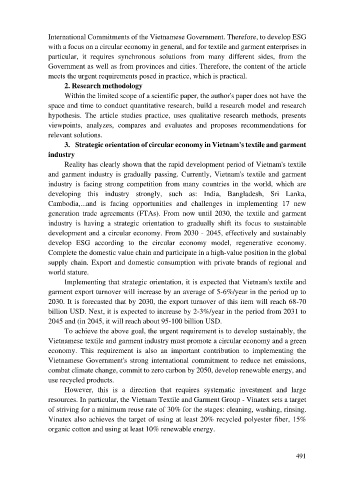Page 499 - Ebook HTKH 2024
P. 499
International Commitments of the Vietnamese Government. Therefore, to develop ESG
with a focus on a circular economy in general, and for textile and garment enterprises in
particular, it requires synchronous solutions from many different sides, from the
Government as well as from provinces and cities. Therefore, the content of the article
meets the urgent requirements posed in practice, which is practical.
2. Research methodology
Within the limited scope of a scientific paper, the author's paper does not have the
space and time to conduct quantitative research, build a research model and research
hypothesis. The article studies practice, uses qualitative research methods, presents
viewpoints, analyzes, compares and evaluates and proposes recommendations for
relevant solutions.
3. Strategic orientation of circular economy in Vietnam's textile and garment
industry
Reality has clearly shown that the rapid development period of Vietnam's textile
and garment industry is gradually passing. Currently, Vietnam's textile and garment
industry is facing strong competition from many countries in the world, which are
developing this industry strongly, such as: India, Bangladesh, Sri Lanka,
Cambodia,...and is facing opportunities and challenges in implementing 17 new
generation trade agreements (FTAs). From now until 2030, the textile and garment
industry is having a strategic orientation to gradually shift its focus to sustainable
development and a circular economy. From 2030 - 2045, effectively and sustainably
develop ESG according to the circular economy model, regenerative economy.
Complete the domestic value chain and participate in a high-value position in the global
supply chain. Export and domestic consumption with private brands of regional and
world stature.
Implementing that strategic orientation, it is expected that Vietnam's textile and
garment export turnover will increase by an average of 5-6%/year in the period up to
2030. It is forecasted that by 2030, the export turnover of this item will reach 68-70
billion USD. Next, it is expected to increase by 2-3%/year in the period from 2031 to
2045 and (in 2045, it will reach about 95-100 billion USD.
To achieve the above goal, the urgent requirement is to develop sustainably, the
Vietnamese textile and garment industry must promote a circular economy and a green
economy. This requirement is also an important contribution to implementing the
Vietnamese Government's strong international commitment to reduce net emissions,
combat climate change, commit to zero carbon by 2050, develop renewable energy, and
use recycled products.
However, this is a direction that requires systematic investment and large
resources. In particular, the Vietnam Textile and Garment Group - Vinatex sets a target
of striving for a minimum reuse rate of 30% for the stages: cleaning, washing, rinsing.
Vinatex also achieves the target of using at least 20% recycled polyester fiber, 15%
organic cotton and using at least 10% renewable energy.
491

